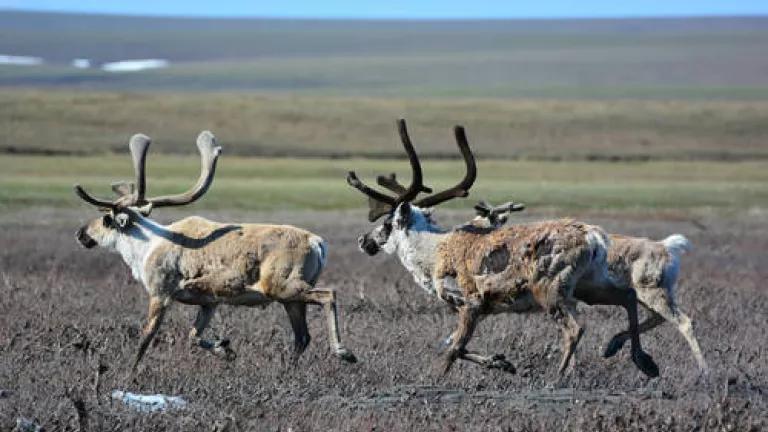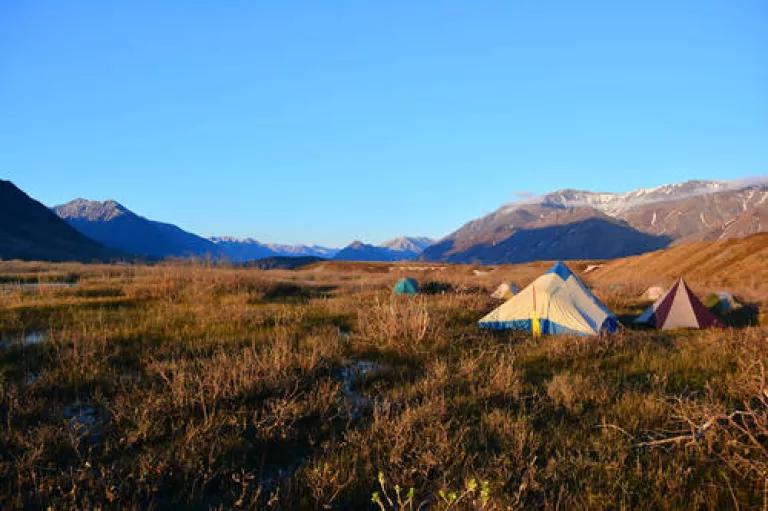
I will never forget the sensation of flying over the Brooks Range in a tiny Cessna. The ride was bumpy, and the light of an endless Alaskan summer day poured through the windows. Snow-covered peaks and slate-gray ridges filled the skyline. Then suddenly we cleared the mountains and the bright green expanse of the Arctic National Wildlife Refuge unfolded before us. Caribou wandered through the grass, patches of purple and scarlet flowers poked through the tundra, and an aquamarine river cut through the landscape. Everywhere I looked, I saw pristine wilderness. It was one of the most beautiful sights I had even seen.
I was thrilled to travel to the refuge last summer. I’ve been drawn to that magical place since my conservation heroine Mardy Murie helped establish it several decades ago. But now the refuge is facing a new round of threats. Oil and gas companies are clamoring to drill in the coastal plain—a push that would forever industrialize what is often called the American Serengeti.
Fortunately, U.S. lawmakers have introduced bipartisan bills to designate the refuge’s coastal plain as wilderness. To move these bills forward, lawmakers have to hear an outcry of public support. The American people own the refuge. If it gets handed over to oil and gas development, we will lose one of the most extraordinary pieces of our natural heritage. But if we raise our voices now, we can save the coastal plain for generations to come.
As Mardy Murie once told a Congressional committee, “I hope the United States of America is not so rich that she can afford to let these wildernesses pass by. Or so poor, she cannot afford to keep them.”Because once they are lost, they are lost forever.
After spending several days floating the Canning River, we flew out of the refuge and soon after leaving the boundary, we ran into oil and gas development. The industrial complex around Prudhoe Bay covers 1,000 square miles of former tundra, 1,500 miles of roads and pipelines, 1,400 wells in production, and more than 60 contaminates waste sites. As my colleague Chuck Clusen said, “It’s like flying over the industrial hub of Gary, Indiana, for a hundred miles.”
The industry wants to bring that development to the wilds of the coastal plain. This is as pristine and fragile an ecosystem as we have left in the US, a touchstone for conservation. If companies breach this barrier, where will they trample next? Greater Yellowstone? The Canyonlands in Utah? The Theodore Roosevelt National Park in North Dakota?
It’s time to recognize that some places are too special to drill, especially when America has cleaner, more sustainable ways to power our cars. Two years ago the Obama Administration raised fuel economy standards to 54.5 miles per gallon by 2025. These standards will cut our oil imports by one-third and save consumers $80 billion a year at the pump by 2025. They will also cut carbon pollution from new cars in half.
We can preserve our last wildlands and keep our economy moving at the same time. Click here to call on our lawmakers to permanently protect the coastal plain of the Arctic refuge before it’s too late.

Photo credits: NRDC Senior Attorney Niel Lawrence
